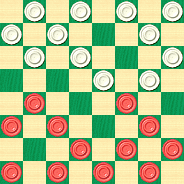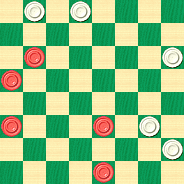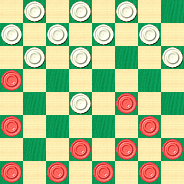The Checker Maven
Jump to navigationAllan Millhone Plays Checkers
To accompany our interview with American Checker Federation President Alan Millhone, we present these two fine games played by Mr. Millhone in the 2006 District 6 Checker Tournament, against no less an opponent than World Champion Alex Moiseyev. The games have been expertly annotated by Dr. Richard Beckwith.


Games from 2006 District 6 Tournament
Game 1
Black: Alan Millhone
White: Alex Moiseyev
10-14 22-18 11-16 26-22---A 8-11---B 22-17---C 16-20---D 17x10 6x22 25x18 9-14---E 18x9 5x14 29-25 7-10 25-22 3-7 30-26 11-15 24-19 15x24 28x19 4-8 22-17 7-11 17-13 11-16 26-22 8-11 22-18---F 1-5 18x9 5x14 13-9 11-15 9-5 15x24 23-19 16x23 27x9 12-16?---G 5-1 10-14 1-6 14-18 6-10 18-22---H 10-15 22-25---I White Wins.

BLACK
Black to play (note D)
B:W32,31,30,29,28,27,25,24,23,21,18,17:B16,14,12,11,9,7,6,5,4,3,2,1.
WHITE

BLACK
Black to Play and Draw (note G)
B:W32,31,21,9,5:B24,20,12,10,2.
A---Also reached from 11-16 23-18 10-14 26-23 same.
B---Natural, but a very weak reply, unless one has a prepared defense. In fact, Solid Checkers gives 8-11 a question mark. The two usual alternatives are 7-10 and 16-20. The 16-20 move permits 22-17 7-10 and the option of a good off-Bristol-Cross variation with 17-13 now, as shown in Basic Checkers Op. # 120 trunk, the line where 24-19 is held back. To keep more options open, 7-10 has been suggested (instead of 16-20 or 8-11), then 22-17 and now black has the option of 16-20 (into the same line just mentioned) or the 16-19 bust.
C---A good move by the world champ, whereas 24-19 allows 16-20 and back into a standard Bristol-Cross.
D---See diagram prior to 16-20. Alan has previously played the published 7-10 here (vs. L. Cowie in 2005 OH Ty.), but I like this 16-20 better! Both BC and SC give only 7-10 25-22 3-7 31-26 9-13 18-9 5-14 23-19 with white powerful.
E---While this will get through to draw, black also has 7-10 as a defense (perhaps new?). Continue with 24-19 (or 29-25 3-7 24-19 11-15) 11-16 and into an old secondary Bristol-Cross defense often used by another Ohio player, Louis Cowie (and occasionally by your annotator as well). This position normally arises from 11-16 23-18 16-20 24-19 10-14 26-23 8-11 22-17 11-16 17x10 6x22 25x18 7-10.
F---13-9 (liked by programs, but not necessarily better) 11-15 32-28 15x24 28x19 1-5 31-26 2-7 22-18 14-17 21x14 10x17 9-6 17-21 6-2 7-10 2-6 10-14 18x9 5x14 26-22 21-25 6-2 (or 6-10 14-18 22x15 25-30 draw) 25-30 2-6 and now pitching the man on 14 is necessary, and then the king can attack the elbow to draw. rcb
G---Sets up a “breeches” problem later. Instead, 10-15 5-1 15-18 31-26 12-16 (now OK with 31-26 played) 1-5 2-7 9-6 16-19 5-9 7-11 (whoops! 18-23 draws this game) 32-27 & 9-14 WW, T. Laverty – R. Jones 1987 Florida Open
H---Now black cannot advance to 23 to set up a trade due to the king advance with 10-15 & 15-19.
I---The scoresheet ended here, but the position will win for white given the three stranded black pieces in front of the double corner, as well as additional white kings “on the way.”
Game 2
Black: Alex Moiseyev
White: Alan Millhone
10-14 22-18 11-16 25-22 16-20 29-25---A 8-11---B 18-15---C 11x18 22x15 4-8---D 26-22---E 7-10 31-26 10x19 24x15 6-10---F 15x6 1x10 22-18---G 8-11 28-24 10-15 25-22 2-7 23-19 14x23 19x10 7x14 26x19 9-13 22-18 14x23 27x18 20x27 32x23 11-16 18-15 16-20 15-11 20-24 23-18 24-27 18-15 27-31 11-7 3x10 15x6 31-27 6-2 5-9 2-6 9-14 19-15 14-18 6-9 18-22 15-10 27-23 21-17 Drawn.

BLACK
Black to Play (note D)
B:W32,31,30,28,27,26,25,24,23,21,15:B20,14,12,9,7,6,5,4,3,2,1.
WHITE

BLACK
Black to play (note F)
B:W32,30,28,27,26,25,23,22,21,15:B20,14,12,9,8,6,5,3,2,1.
A---A natural development, but 24-19 is preferred, or taking the Bristol-Cross a move earlier, as Alex did in Game 1. Historically, 29-25 has thrown the advantage back to black.
B---This position is also reached by either 11-16 22-18 16-20 25-22 8-11 29-25 10-14 or by 12-16 22-18 16-20 25-22 8-12 29-25 10-14.
C---24-19 is known to be “bad” by well-versed players due to the bind, but narrow draws do exist. Continue: 11-16 (4-8 19-15 7-10 27-24 draws) 18-15 4-8 28-24 7-10 15-11* (instead of 22-18 and Ryan’s “Pickle Barrel trap” given in Solid Checkers) 8x15 23-18 14x23 27x11 16x23 26x19 20x27 31x24 10-15 draws, Wyllie-Barker, 1882, from 11-16 24-19 8-11 opening.
D---See diagram prior to 4-8. There are three established options here, with 7-10 (Var. 1) being best for black, and a review of the OCA database reveals the majority of these games have resulted in black wins. The 4-8 played here has historically favored white. The third option is 9-13 (Var. 2), as given in Basic Checkers Opening #116 trunk.
E---Well played by Alan, leaving black to use care to draw. 24-19 instead is wanted, then 7-10 leads to the “bad stuff” for white in Var. 1.
F---See diagram prior to 6-10. Not 14-18? 23x14 9x18 21-17* (instead of 26-23 3-7 23-14 6-10 draw, Gonotsky-Lieber, 1928) 2-7 26-23 6-9 23x14 9x18 30-26 1-6 26-23 12-16 23x14 7-10 14x7 3x19 25-21* 5-9 22-18 9-13 17-14 13-17 18-15 17-22 21-17 22-26 17-13 8-12 27-24 20x27 32x23 26-31 23-18 31-26 14-9 26-23 9x2 23x14 15-10 WW, J. Hanson.
G---Leads to a quiet draw, likely unpublished. (And any quiet draw for an “average” player against a world champ is a good one!) The usual press is with 23-18 14x23 27x18 9-13 18-14 10x17 21x14 2-6 22-18 6-10 14x7 3x10 26-23 8-11 23-19 20-24* 19-16 11x20 28x19 to a draw, Rubin-Hunt 1934 Am. Ty., from 12-16 22-18 16-19 opening.
Var. 1 7-10 24-19---1A 4-8 27-24---1B 20x27 31x24 9-13 (2-7 also strong) 24-20 3-7 25-22 5-9 30-25!---1C 1-5 22-18 14-17 21x14 10x17 19-16 12x19 23x16 17-21 16-12 21x30 12x3 30x14 3x1 to a strong black ending, but probable draw. RCB.
1A---Very weak, now that the draws of note C have been bypassed. White should play the 25-22 10-19 23-16 pp draw.
1B---Basic Checkers also mentions 26-22 and 23-18, but both are given to lose. The 27-24 is the best bet to draw, although the line should be avoided altogether.
1C---Instead of 22-18 or 32-27 in BC, Op 116 note F1.
Var. 2 9-13 26-22---2A 5-9---2B 22-18---2C 7-10 30-26*---2D 10x19 24x15 3-7 25-22 7-10 15-11 12-16---2E 22-17 13x22 26x17 16-19 23x16 14x23 27x18 10-14 17x10 6x22 11-7 Drawn. RCB.
2A---Or 24-19 4-8 28-24 as in BC, Op #116 trunk.
2B---Or 13-17 & 6-9 draws, which may be best if the upcoming 30-26 improvement is feared.
2C---31-26? 7-10 22-18 10x19 24x15 3-7 25-22 (starred in BC, but appears to lose given upcoming correction) 7-10 23-19 14x23 27x18 10-14 26-23 20-24 15-10 6x15 18x11 24-27 19-15 13-17* (correcting 1-5 to draw in BC) 22x6 1x26 30x23 12-16 28-24 27-31 24-19 16-20 19-16 31-27 BW. RCB.
2D---Avoiding 31-26 and back into the previous note. White is now better after 30-26.
2E---10-15 28-24 12-16 24-19 15x24 18-15 16-19* 23x16 14-18 15-10 18x25 32-28 6x15 28x10 25-30 26-23 2-6* 10-7 6-10 7-2 10-14 2-7 1-5 16-12 30-26 31x22 14-17 21x14 9x25 Drawn. RCB.
And now, as a special bonus for those of our readers who have come this far, we present a game in which we know Mr. Millhone takes great pride; a game in which he made a draw against the greatest checker player of all time, Dr. Marion Tinsley.


Black: Marion Tinsley
White: Alan Millhone
11-15 23-18 8-11 26-23 10-14 30-26 6-10 24-19 15x24 27x20 2-6 28-24 10-15 32-28 7-10 22-17 15x22 25x18 10-15 17x10 15x22 26x17 6x15 29-25 9-13 17-14 15-18 24-19 18x27 31x24 3-7 25-22 1-6 19-16 12x19 24x8 4x11 22-18 13-17 28-24 6-10 24-19 17-22 21-17 22-26 17-13 10x17 19-15---A Drawn.
A---The only move to draw, and a fitting conclusion to a game played without even the smallest of errors.
Mr. Millhone modestly calls himself "an average player" but these games show that if this is "average" play, wouldn't we all like to be "average" ourselves!![]()
You can email the Webmaster with comments on this article.
